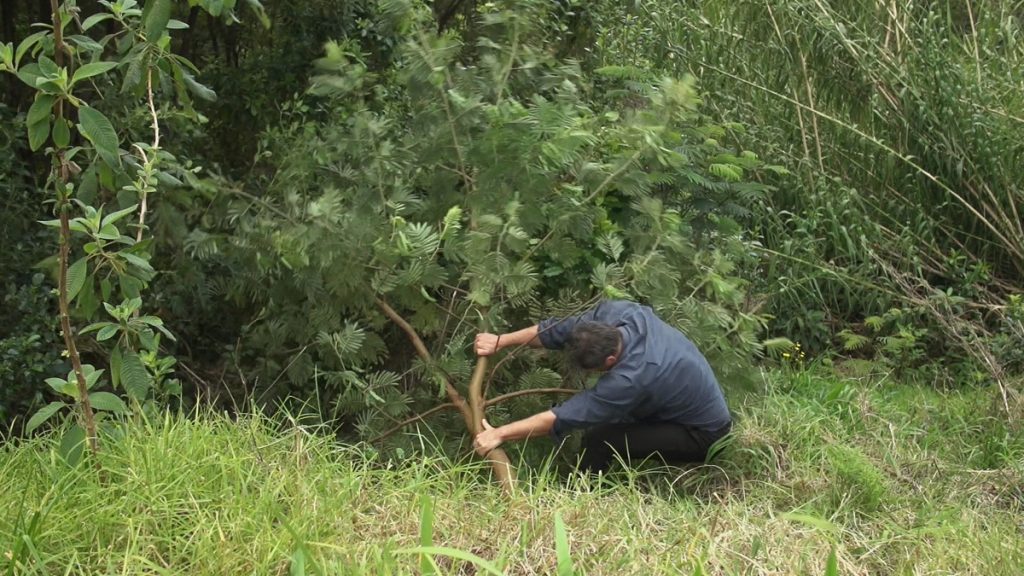
I’ve descended into a dark room with a large video projection of what looks like a tropical jungle. The camera moves slowly and deliberately through rich vegetation while the narrator— New Zealand artist Mark Harvey—gently talks to you about Schrödinger’s Cat. Mark explains how plants absorb energy from other nearby plants, and the research suggesting this applies to people too. He talks about quantum entanglement. The whole thing is quite hypnotic. And sitting on the floor in the far corner of the room, is a small video monitor showing the artist wrestling with a young tree, yanking and pulling, trying to rip it out of the ground with his hands.
Mark visited Halifax’s Anna Leonowens Gallery this summer, presenting a video installation, Drop Point, alongside a series of daily public performances, titled Free Hand. I spoke with Mark over lunch about his work, colonialism, caring for plants, religion, quantum physics (some real, some not), optimism, and life advice from our grandmothers.
DANIEL HIGHAM: I found that small video of you wrestling the tree really interesting because it was just so violent compared to the rest of the work.
MARK HARVEY: It’s interesting to hear you say that. It seems a lot of people don’t notice the tree being pulled out in the corner. So the forest in the main video is, you could argue, “pure” New Zealand forest—all endemic and rare species—and it’s actually my back yard. We live out in the rain forest, and I do a lot of caring for it, and I look after other people’s land in the area as a hobby. I get rid of invasive weeds and replant native species.
DANIEL: You could tell by the way the camera moved through the space, that you really knew the land. It was almost intimate, very slow and considered.
MARK: Yeah, I did. I also filmed it with a Steadicam. I wanted to seduce or hypnotize the viewer. Some of my earlier background is in contemporary dance, holistic contemporary dance, conditioning your body, often touching on the New Age kind of thing. So there is that, but I’m also interested in the politics of the space—art galleries—and also the psychology of it. For this work, I collaborated partly with a physicist, Shaun Hendy. So some of the quantum physics that’s coming into the video is coming from him, but some of it is spoof physics—it’s not actually scientific.
DANIEL: But it’s presented in this authoritative sort of way, with a lot of seemingly factual information.
MARK: I was worried it might be a bit naughty to do it.
DANIEL: It is! At one point you say, “We’re all matter extending out into space,” and that we all contain lead.
MARK: Yeah! Apparently we do! That’s from Shaun.
DANIEL: So that part is real.
MARK: That part is, yeah.
DANIEL: It reminds me of something I read recently that said we’re actually all experiencing the Big Bang right now, that in this very moment it’s still happening.
MARK: It’s still resonating.
DANIEL: And we’re part of it—it’s what we are.
MARK: You know there’s an ongoing earthquake going on back home? It’s been going on for I don’t know how many years—five years, six years?—but it’s very slow and subtle, and there’s constant shifting going on.
DANIEL: And it’s always changing.
MARK: A teacher of mine years ago used to say that the landscape really affects and influences what you do on it, when you make stuff. I definitely think that’s true for what I do even if I don’t mean it to. And going back to the video off to the side, I wasn’t sure at first if I would include that or not. All the species that you see in that are invasive weeds.
DANIEL: See, I wouldn’t have known that because I don’t recognize any of those plants.
MARK: It actually is a problematic tree and it’s really futile to try and pull it out with bare hands. It’s a work in itself that I’ve shown elsewhere, but I felt like bringing it back in as part of a conversation, so the New Age sort of experience doesn’t seem all too dominant—although people can relax, it’s not as simple as that. We often relax and accept our role as colonizers, we kind of take it for granted. Despite being half Scottish and English, there’s also Maori in my ancestry, so that does influence how I’m thinking about politics. But I don’t want to say it too directly. And it’s only recently that we’ve clarified in my family that ancestry. Years ago when I did a PhD, I was very interested in critiquing the position of White Man through being a white man.
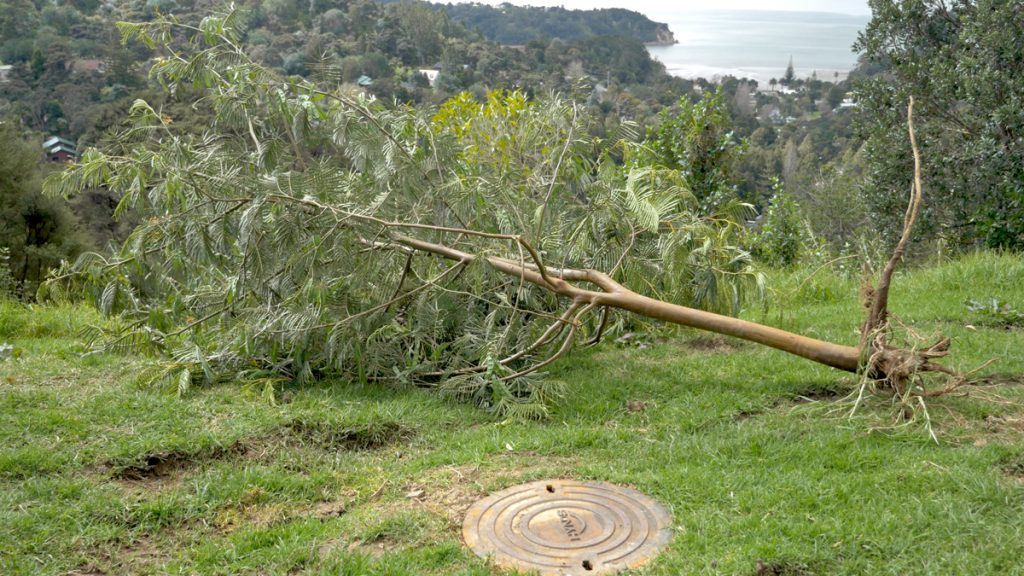
DANIEL: I was watching that video, going along with it, feeling comfortable, relaxed. Then there’s a point in the video where you keep repeating the word “whiteness.” That really unsettled me.
MARK: Yeah.
DANIEL: And then you talk about the colour Alabaster White, and the history of the “white cube,” which may have been started in Nazi Germany, where they began painting the walls of museums white. You say something in the video like, “Whiteness… whiteness, and darkness.”
MARK: Yeah. “Colonizer and colonized. Breathe in. Now breathe out.” The landscape painting, going back to the nineteenth century, it’s often landscapes done by people from colonizing cultures representing land that was there to be conquered or taken over. Empty space ready to be tamed and pastoralised. I think there’s that kind of tension in the work as well.
DANIEL: That reminds me of the “Doctrine of Discovery,” where Pope Nicholas V basically said, go out into the world and take everything that isn’t Christian and make it ours.
MARK: Exactly. And then in the video I start going on about Roman arches, to reference that and all of the things we associate with Roman culture, patriarchal culture, colonization, all of these things.
DANIEL: You mentioned that you started in contemporary dance. How did you end up in performance art?
MARK: Yeah. I started in contemporary dance and very quickly moved toward performance art. You know, twenty years ago—I can’t believe it was twenty years ago, 1998—I was being told not to do that stuff by a lot of people in that community, that I would alienate people, so I moved into visual arts.
DANIEL: What kind of stuff?
MARK: I was doing these great big actions with very simple… for instance, I had my uncle’s drag racing videos—he was into drag racing, hot rods and things—and I had a friend on a reverb pedal playing the sound from the video of the revving engines, looking like a rock star. It was this white man thing I was looking at. It was quite theatrical. I called it HEMI 265, which was the name of an engine in these iconic Australian cars that were big back home, associated with masculinity, macho-ness, and tradesmen—guys who vote for the Tories, that kind of thing.
DANIEL: Toxic masculinity.
MARK: Exactly. And group-think. My first degree was in psychology, and a big thread in all of my work is: what decisions do people make, and why do they make those decisions? There’s a psychologist, Niki Harré, who’s written some books recently that look at why, in relation to sustainability and social justice, people make the decisions they do, and why they often don’t go near this stuff.
DANIEL: Why people avoid it?
MARK: Yeah, it’s fascinating to me. We are in a bubble in the art world, and that is a risk. Some of my works, I definitely try to do out in the public. The first performance I did here last week, I had this huge plastic container—made in Canada—filled with dirty oil, which was made in Canada too, and I was asking people, bystanders, to give me a hand and asking them what they liked about Canada.
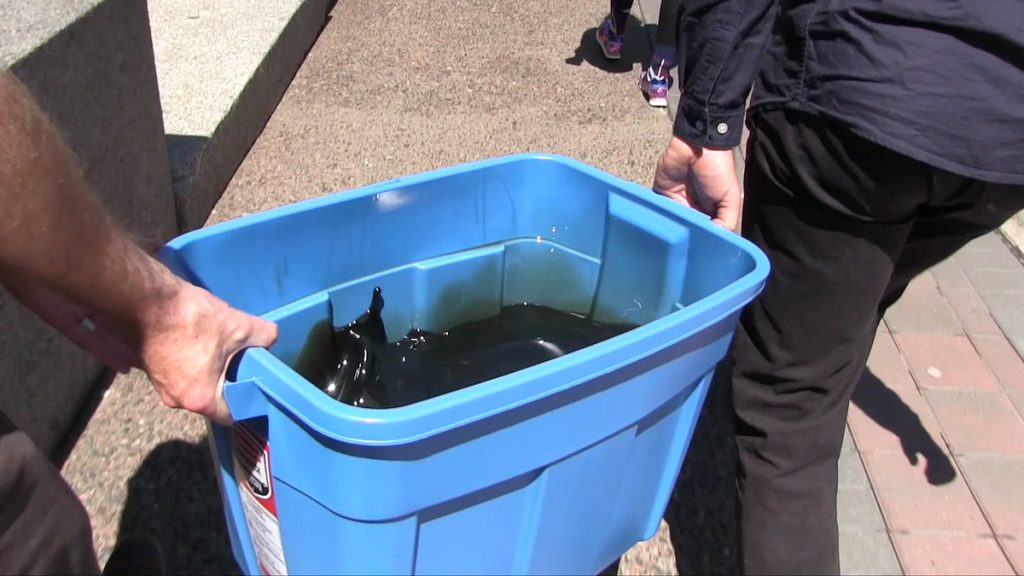
DANIEL: I really liked how precarious that performance seemed at times. I was watching the oil slosh around in the bucket as people helped you carry it, wondering if it would spill. I think that’s a good metaphor for the situation that we live in: we’re moving around all this oil, always on the brink of some catastrophe, not really thinking about it. It was also interesting to see people react—they seemed scared of it, as if they’ve never actually seen oil before. But all of the lights in here are on because of oil.
MARK: And because of my accent, I could play the tourist. But I don’t want to take advantage of people, there’s a risk of that too, you know being patronizing.
DANIEL: Or tricking them into something they might not agree to.
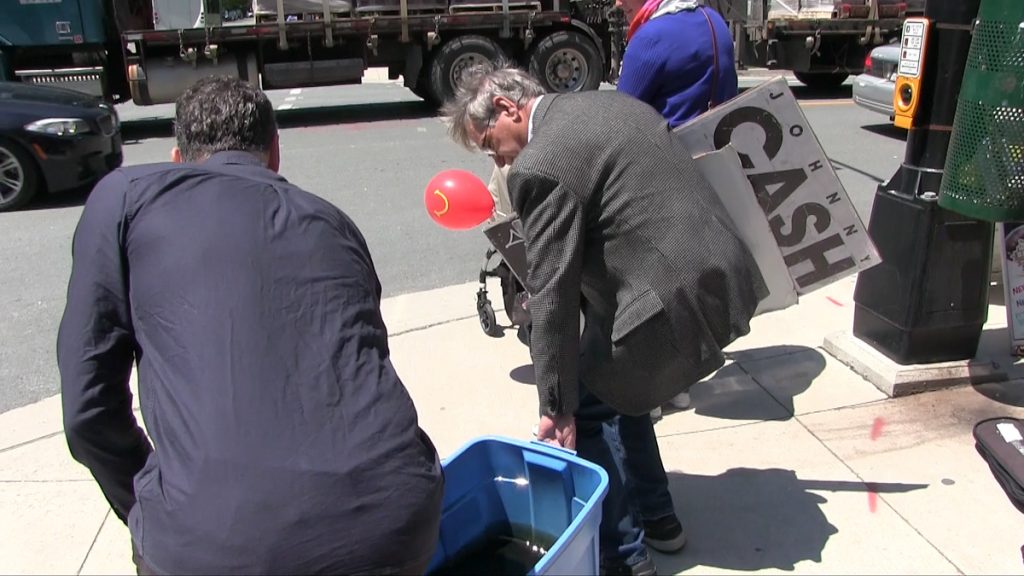
MARK: Yeah. I did a work last year, where for five hours I was pulling things around this city precinct. Mostly it was wreckage left over from the earthquake. There’s still bits of wreckage. I would go from one place to another, but always towing something around, trying to look useful. And sometimes people would come up to me and ask what I was doing, so I’d ask them “do you wanna give me a hand?” It was really fun. I was also pushing a van sometimes, and that especially got people involved. I’d say, “Yeah, this is an artwork! I’m doing this for an artwork, do you want to give me a hand?”
DANIEL: I like that you tell people it’s art.
MARK: I believe in being up-front with people, and not taking advantage of them. I believe that art hopefully can be educational for people. One common response from people was, “Oh, I don’t think it’s art. But I still really enjoy it. I do really like it.”
DANIEL: [laughs]
MARK: While I’ve been here, in Halifax, I’ve been taking time to talk to people outside of the works, and I went and visited the Mi’kmaw Native Friendship Centre and accidentally got myself invited into a language class. So I joined in! It was fantastic, I loved it because it was like an exchange, lots of conversations. In return I shared lots of the Maori language, Te Reo.
DANIEL: Is it spoken much?
MARK: We use Maori words all the time in New Zealand, I think four percent of our population are fluent, and there’s a lot of us, at least half of us, that understand quite a bit. They’re trying to make it compulsory. The Maori population is 15 percent, but it’s more like 25 for people who have Maori ancestry.
DANIEL: That’s great, that it’s being recognized at that level.
MARK: It’s an official language. We have three: English, Maori, and sign language.
DANIEL: Unfortunately Indigenous languages in Canada are at risk of dying out, because of the residential school system and many years of systematic cultural genocide. There’s a whole generation who were violently cut off from their language.
MARK: It happened too in New Zealand, but there was a bit of a renaissance in the ‘80s.
DANIEL: I’m excited about the new Friendship Centre. It will be this beautiful space right across the street from the Halifax Police headquarters, which is this really oppressive sort of building.
MARK: I know, I observed it while I was crawling around the Citadel. I was trying to listen to the power here.
DANIEL: Did the public interact with you while you did that performance?
MARK: A little bit, yeah. I had a whole bus load of tourists that were calling out to me and cheering me on.
DANIEL: What did they say?
MARK: People were yelling out, “WHY ARE YOU CRAWLING?” And it was the only work where I wasn’t talking to people. But it felt like a silent crawl might be the right thing. It was the day after I went to the Mi’kmaw Native Friendship Centre. The Citadel is a place I know where people do drugs, and also a cruising place, but what it meant historically: the British colony, and because of my family, I felt like doing a listening performance. Just listen. It took nearly two hours.
DANIEL: Why were you crawling?
MARK: This idea of submission, submissiveness. Sometimes invaders might crawl before an attack, but in this case I wanted to put myself below, below them, below this place. It’s interesting because on the one hand, I come from colonizers, but on the other hand I don’t, I come from the opposite.
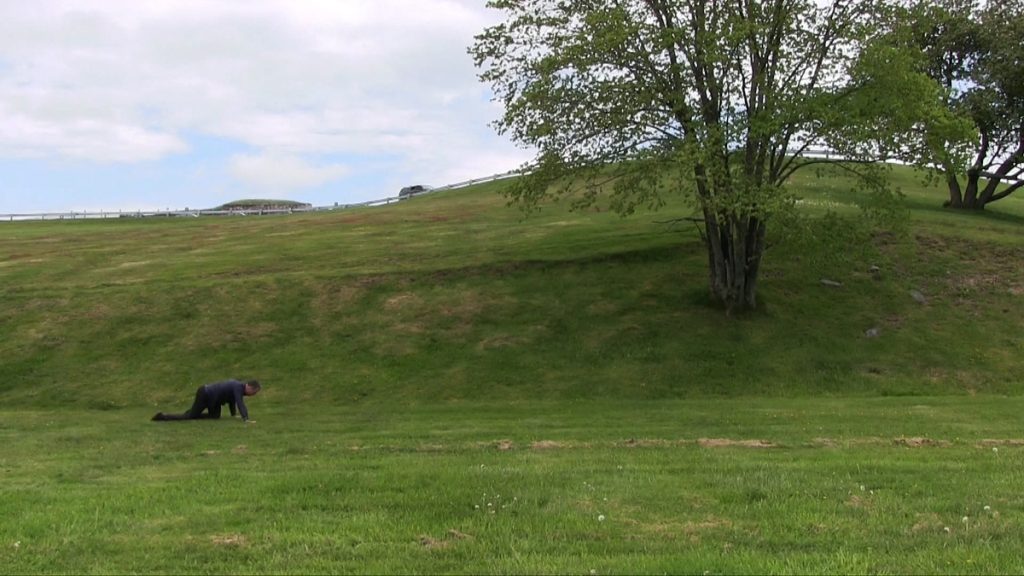
DANIEL: I think there’s important work to be done—by white men, like me—looking at what it means to be a white man, in what was the British Empire. That I need to figure out for myself who I am and how I want to participate in society. That we can’t just blindly follow along with how things are. Which reminds me of the performance you did today, Thought Leader, I think you called it? You put on a blindfold and asked people to guide you around Parade Square, but also to think for you. I feel like a lot of people unwillingly or unknowingly give away their agency. And I think a lot of people just want someone else to make decisions for them.
MARK: Yeaaaaah. I’ve been so wound up and bothered that we give all this power to the same, really powerful, usually white men, and follow what they say.
DANIEL: I’ve noticed in your performances, where religion comes up, a lot of participants are very anti-religion. And I think that’s sad in some ways. Obviously the church has done a lot of harm, and that needs to be acknowledged and repaired. But it seems like we’ve almost given up entirely on moral decision making, so that at the government level we purely rely on statistics or economic factors. And somehow we’ve come to accept that. Like trying to do good is too hard, so we gave up altogether.
MARK: I’ll go back to Niki Harré’s book. What I read from her writing, is that what influences people around big political issues—things like poverty, climate change, equality—is what’s sacred to people, what is going on for people at a spiritual level. And it’s only connecting people with that that moves people to make these deeper commitments or changes. It’s very hard to do. I’ve got this conservation buzz going, I guess that’s probably my religion. I go out into the bush and get really excited learning about different plant species, helping neighbours with them, it’s really wonderful. That for me is a big driving thing. Definitely. And I’m optimistic about it. I’ve got two kids, two daughters, and want them to be better people than we are, if I can help it. If my work can contribute to conversation about these things, that would be nice.
DANIEL: I think conversation is the only way to really make positive change, conversation in whatever form it might take. I really appreciate how some of your performances are actually just frameworks to have pointed conversations with the public. Like with Life Advice, there was this whole setup—you’re doing this workout routine, there’s free fish and chips—but really you’re just asking people for advice.
MARK: Life tips! We got a few too, didn’t we? It was really nice.
DANIEL: And most of the advice that people shared came from their grandmother.
MARK: You’re right! It really shows how important grandmothers are. How underrated they are.
DANIEL: One more question, on the theme of life advice. What advice do you have for someone early in their career in the arts doing something like performance art?
MARK: Keep trying stuff out, especially if others around you are not doing it. And definitely don’t feel like you have to follow the norms—performance has been around long enough now that it has its norms. That’s really important. There are friends of mine in Germany who say there are a lot of young artists that have been taught to do performance art and it all looks kind of the same, often just standing there and dropping things.
DANIEL: I think sometimes just trying to challenge the norm becomes the norm.
MARK: Exactly. Like the idea that all performance art should be about pulling apart things—that in itself is like a cat chasing its tail. That can undo the very essence of the work, if it has that potential. It’s like, when you try to fall over, you never are falling over because you’re conscious of doing it. Stick with concepts rather than trying to constantly pull apart things. And don’t listen to me about things. Or older people. Unless you really think they should be listened to.

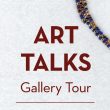














Leave a Reply